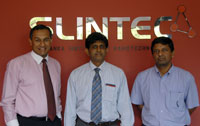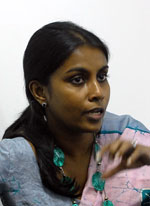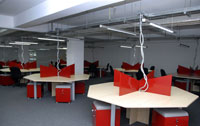
The core team Ravi Fernando, Prof.Veranjan Karunaratne and Prof Ajith de Alwis |
|
At the Biyagama Free Trade Zone, about 20 km east of Colombo, an ambitious and technologically advanced project is taking shape intended to propel Sri Lanka right up in the development of science for commercial use, in the global marketplace.
The Sri Lanka Institute of Nanotechnology (SLINTEC) is preparing to open by May this year and in two to three years time to produce Sri Lankan nanotechnology intellectual property and patents which deliver a competitive advantage for Sri Lankan industry.“It’s ambitious… but we will get there as our vision is to be the leading research and innovation platform for sustainable nanotechnology in Asia.” believes Ravi Fernando, its CEO, seated in spanking new offices and labs that would be the envy of any local scientist.
“With cutting edge technology, this is the country’s best-kept secret. Sri Lanka has never really had this kind of science and technology infrastructure before,” he said while introducing the core team that would drive the country to be pitted against the best in the West in terms of competitive commercial products.
Currently the team, under a unique public-private partnership project, is putting together a group of Sri Lanka’s best scientists plus a panel of the country’s best brains based overseas and among them, the world’s best.
What is nanotechnology? Prof Veranjan Karunaratne, one of two science team leaders at SLINTEC, explains in common, understandable terms; “Take clothes for example with nanotechnology in it, you may not need the washing machine because of self-cleaning clothes. Any stain or dirt will disappear within 48 hours if left in the sun without washing.” Some of these shirts are already in the global marketplace developed by multinationals.

Ms Gayanie Lokuge |
|
Prof Ravi Silva, Director of Advanced Technology Institute (AT) of the University of Surrey, UK, Prof. Gehan Amaratunga, Professor of Engineering and Chairman Nanotechnology focus group at Cambridge University, Prof Prassana De Silva, Prof. of Chemistry (Queens University of Belfast) and Prof. Kumar Wickremasinghe, IBM Fellow and Senior Manager Nanoscale Science and Technology, make up the 4-member panel of ‘overseas minds’ that would guide the project and the local team. Prof Silva, quoted in a recent publication and one of the initiators of nanotechnology in Sri Lanka, says; “Nanotechnology is about the making of, manipulation and production of goods and services associated with materials that are measured in the dimensions of between one and 100 nanometres. Hence in effect, nanotechnology is about using the smallest building block available to humankind to produce products and service.”
Prof Ajith de Alwis, the other Science Team leader, notes that nanotechnology is a science of chemistry, physics, biology and medicine, put together. Still unsure (what it is)? In another simple explanation of this science for commercial use, Prof de Alwis says,” Nano (combination of atoms) can be used for anything that you see in front of you.” Picture seated inside a bedroom and what you see around – bed, clothes, bottles, cosmetics, clothes rack, cupboards, shoes, etc can have nano in it to enhance its value and longer use. Or picture yourself in a pharmacy – all the medicines can have nanotechnology. It’s the latest and most advanced technology for mankind – and its right here in Sri Lanka.
Initiatives towards taking Sri Lanka to the nanotechnology age came two to three years ago when some top Sri Lankan scientists broached the subject at a Colombo seminar and in discussions with Science and Technology Minister Prof. Tissa Vitharana, who has always been keen to increase funding for science and apply the research for commercial use that would benefit the country.

The workstations |
|
The partnership between the government and the private sector (five companies all exposed overseas – Brandix, Dialog, Hayleys, Loadstar and MAS Holdings) is a strictly business arrangement to make it work. The initial investment is Rs 450 million in the first year with Rs 250 million coming from the National Science Council (under the Ministry) while the balance is shared by the five companies (Rs 40 million each). The five companies will own 10% each of the stake, with the balance 50 % held by the government. Separately the government is committed to Rs 5.6 billion investment over five years. SLINTEC will be the research and development arm or incubator while the commercial or production facility is NANCO, the proposed Nanotechnology Centre and the Nanoscience Park on a 50-acre land at the Homagama Industrial Park, which will come up in about three years. SLINTEC, now temporarily housed at the Silueta (Part of MAS Holdings) premises at the Biyagama zone, is also expected to move to the Park in a few years time. Walking into the SLINTEC facility, it looks impressive and like a sophisticated Western lab unit with modern furniture while the lab equipment, among the most expensive and best in the world, has been ordered and due shortly. Every effort is being made to ensure a comfortable and pleasant working environment for the scientists.
More than the furniture or its facilities, the background of the core team and the panel of advisors is very impressive – with two of its advisory team (Prof Gehan Amaratunga and Prof Ravi Silva) along with Prof Ajith de Alwis being PhD’s from the Cambridge University while Mr Fernando has a Post Grad. in Sustainable Business from Cambridge as well. Recruitment for another 10-15 scientists is underway leading, subsequently, to around 40 scientists, essentially with a scientific research background, on the payroll. The staff structure is project-based, meaning recruitment will be for specific projecs, according to Mr Fernando. Most of the staff will come from universities and would be on a contractual basis. At the moment, the five private sector companies have assigned two projects each, totaling 10 projects, to the institute to carry out research, and development leading to innovative nanotechnology that would enhance their products, make it more efficient and competitive in the global marketplace.
Discussing the reasons for the creation of SLINTEC, Prof. Karunaratne said although the government has funded scientific research it has been a neglected issue since there has been no benefit accrued to the country. SLINTEC will fill that gap and make money for the industry using science. Eventually consumers will also benefit.
Failure is not an option in this project, according to both Prof de Alwis from the University of Moratuwa and Prof Karunaratne from the University of Peradeniya. “We must succeed, we have to, there’s a lot riding on this project and we need to make it happen,” one of them said.
Asked why Sri Lanka needs a nanotechnology lab facility when these products are already developed overseas and could be replicated or imported for use, Prof Karunaratne said, “we want to innovate with a view to creating Sri Lankan patents and products through this platform.” He said by 2015, nanotechnology is Globally projected to be a US $ 1 Trillion industry, creating more jobs. “We could be an outsourcing operation to the world. We have good brains and low cost structures.
”SLINTEC CEO Fernando says Sri Lanka has an opportunity to differentiate itself through sustainable nanotechnology that will enhance the environment, not impact on social systems negatively and contribute to economic competitiveness.”
“We have a huge opportunity to take the nation forward through this initiative,” said Ms Gayanie Lokuge, SLINTEC’s HR Manager, “ as we have a data base of 70 Sri Lankan nanotechnology scientists worldwide who will chip in with their time to enable Sri Lankan companies to compete with the best in the world.”
|



